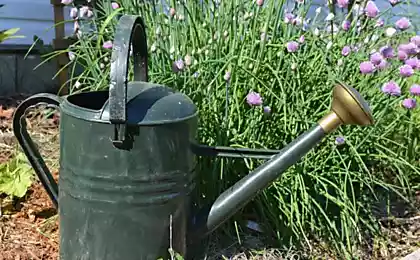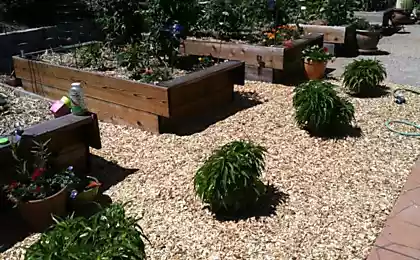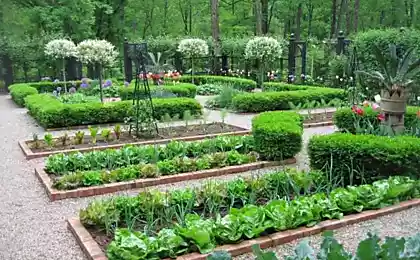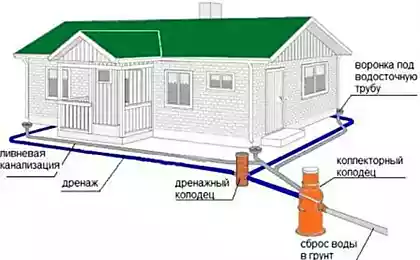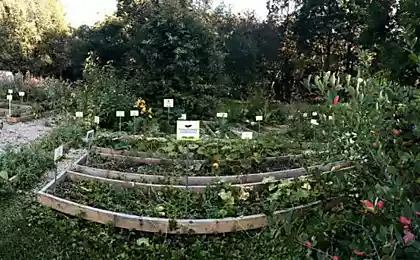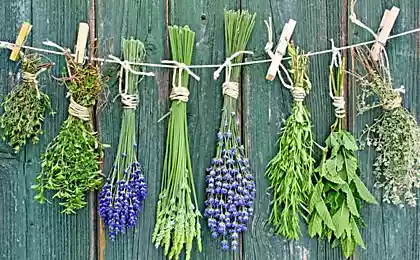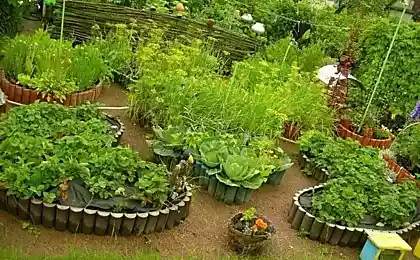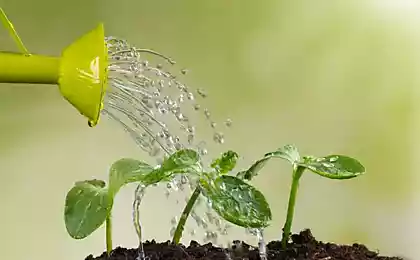253
Proper watering of plants on the site
The heat and drought this year caught us unusually early. It is only May and the weather is quite July. And just like in the middle of summer, plants need water. Usually in the spring we have rains - not uncommon, and the nights are cold, with dews, so you have to think about watering much later.
Although, to be honest, I did not think much about it: everything is intuitive. And then I decided to figure out how to properly water the garden: how much water each vegetable needs; how to determine whether the plant suffers from thirst; with what frequency to water the beds, and so on. It turned out - not in vain decided: I learned a lot of interesting things for myself. I'll share, maybe you'll need it.
Cabbage watering is perhaps the largest waterbread of all vegetable crops. When she ties the knots, the irrigation rate is at least 30 liters per 1 sq.m. If cabbage suffers from thirst, it is immediately attacked by pests - cruciferous flea and cabbage fly. On the leaves of the plant may appear pinkish-blue plaque.
Cabbage, it turns out, needs to be watered in different ways, depending on the weather: if it is hot and dry, rain is used, and in cool weather it is watered under the root. In this case, the soil should be wet to a depth of at least 40 cm.
Late varieties of cabbage are recommended to be watered daily, and early ones - every 2-3 days, preventing the soil from drying up. If after a drought you decide to water the plants abundantly or suddenly it rains, this will only lead to the fact that the nomads will crack.
About the fact that the plant is thirsty, its leaves signal: in drought, they grind, take a vertical position, twist. Flowers and formed ovaries may fall, and if the fruits are already poured, they slowly grow and mature, often top rot appears on them.
Watering tomatoes should be at the root - raining is permissible only in very hot and dry weather. Excess moisture in the air can cause illness. Morning watering is recommended for this culture. When the first flowers appear, water once a week, and then every 10-12 days, spending 1 sq.m. 30 liters of water.
Cucumber likes water, so you need to water it often. Although it was a rather contradictory nature : Judge for yourself:
Suffering from thirst eggplant and pepper stop in growth and do not bloom. To avoid such a scourge, every 7-10 days they need to be watered, consuming 15-30 liters of water per 1 sq.m. (depending on weather conditions).
Water the plants under the root or in the furrows laid along the row. In the heat, you can use morning or evening irrigation, and if the temperature drops below +15 degrees, watering should be completely excluded - otherwise there is a risk of damage to plants with gray rot.
How much water need carrots and beets Seeds carrots before the appearance of the first shoots should be in moist soil. Often gardeners use film: it does not allow moisture to evaporate, and water the carrot bed can be much less frequent. With the appearance of shoots, the film must be removed, and then every 10 days abundantly water the planting, using a watering pot with a small strainer. 3 weeks before harvesting watering is stopped. Water consumption - 30 liters per 1 sq.m.
If there is not enough water, carrots can form a coarse, ugly root crop, or even throw out the flower plant altogether. The fact that the plant suffers from thirst, you can guess by slightly twisted and darkened leaves.
But beets do not require such care - you can water it much less often. For the whole season of sowing beets, it is enough to water 4-5 times (of course, if there is not a strong heat, and periodically there are rains). Water consumption is the same as for carrots, and watering is recommended in the early morning or evening, in the grooves along the plants.
But overdrying beets is also not worth it: from drought, it, like carrots, can go to the formation of peduncles instead of forming a root crop. And if it does, it will be hard and tasteless. The lack of irrigation of beets signals the brown-purple color of the foliage, which, moreover, is noticeably small in drought.
When you need watering onions and garlic Yellow tips of the feather remind: it's time to water. But if the weather is rainy, these crops do with natural moisture; in dry and hot, you will have to go to the garden with a watering pot or hose every 5-6 days.
When about a month is left before cleaning, watering should be stopped altogether: from excess moisture, the bulbs mature worse, and then poorly stored in winter. Most of all, plants need water when the bulbs are poured - the norm at this time is 30-35 liters per 1 sq.m. In spring, while the root system is formed and leaves grow, no more than 30 liters per 1 sq.m. are used.
These cultures need water not too often, but a lot:
Let me be honest: I never watered potatoes until this spring. I read, of course, that he also needs watering, but he grew well without it. And then I was afraid that in the dry hot ground tubers would simply bake instead of sprouting.
And in fact, it is recommended to water potatoes once a week, 20-30 liters of water per 1 square meter of plantings. If after watering the soil is slightly dried, loosened and mulched with humus or peat, then you can do it once a month.
Source: www.7dach.ru
Although, to be honest, I did not think much about it: everything is intuitive. And then I decided to figure out how to properly water the garden: how much water each vegetable needs; how to determine whether the plant suffers from thirst; with what frequency to water the beds, and so on. It turned out - not in vain decided: I learned a lot of interesting things for myself. I'll share, maybe you'll need it.
Cabbage watering is perhaps the largest waterbread of all vegetable crops. When she ties the knots, the irrigation rate is at least 30 liters per 1 sq.m. If cabbage suffers from thirst, it is immediately attacked by pests - cruciferous flea and cabbage fly. On the leaves of the plant may appear pinkish-blue plaque.
Cabbage, it turns out, needs to be watered in different ways, depending on the weather: if it is hot and dry, rain is used, and in cool weather it is watered under the root. In this case, the soil should be wet to a depth of at least 40 cm.
Late varieties of cabbage are recommended to be watered daily, and early ones - every 2-3 days, preventing the soil from drying up. If after a drought you decide to water the plants abundantly or suddenly it rains, this will only lead to the fact that the nomads will crack.
About the fact that the plant is thirsty, its leaves signal: in drought, they grind, take a vertical position, twist. Flowers and formed ovaries may fall, and if the fruits are already poured, they slowly grow and mature, often top rot appears on them.
Watering tomatoes should be at the root - raining is permissible only in very hot and dry weather. Excess moisture in the air can cause illness. Morning watering is recommended for this culture. When the first flowers appear, water once a week, and then every 10-12 days, spending 1 sq.m. 30 liters of water.
Cucumber likes water, so you need to water it often. Although it was a rather contradictory nature : Judge for yourself:
- before the start of flowering cucumbers can be watered no more than once a week (and even not watered at all if it rained) - so that plants develop a strong root system; when flowers appear, water every 3-4 days, and even daily (if there is a heat);
- for cucumbers, raining is preferred - their leaves actively evaporate moisture; but if you find spots on the leaves indicating a plant disease, raining should be excluded and watered only in the grooves laid along the row of plants;
- in warm weather, water should be watered in the afternoon, but until 17.00, and if the nights are cold, morning watering is recommended.
Suffering from thirst eggplant and pepper stop in growth and do not bloom. To avoid such a scourge, every 7-10 days they need to be watered, consuming 15-30 liters of water per 1 sq.m. (depending on weather conditions).
Water the plants under the root or in the furrows laid along the row. In the heat, you can use morning or evening irrigation, and if the temperature drops below +15 degrees, watering should be completely excluded - otherwise there is a risk of damage to plants with gray rot.
How much water need carrots and beets Seeds carrots before the appearance of the first shoots should be in moist soil. Often gardeners use film: it does not allow moisture to evaporate, and water the carrot bed can be much less frequent. With the appearance of shoots, the film must be removed, and then every 10 days abundantly water the planting, using a watering pot with a small strainer. 3 weeks before harvesting watering is stopped. Water consumption - 30 liters per 1 sq.m.
If there is not enough water, carrots can form a coarse, ugly root crop, or even throw out the flower plant altogether. The fact that the plant suffers from thirst, you can guess by slightly twisted and darkened leaves.
But beets do not require such care - you can water it much less often. For the whole season of sowing beets, it is enough to water 4-5 times (of course, if there is not a strong heat, and periodically there are rains). Water consumption is the same as for carrots, and watering is recommended in the early morning or evening, in the grooves along the plants.
But overdrying beets is also not worth it: from drought, it, like carrots, can go to the formation of peduncles instead of forming a root crop. And if it does, it will be hard and tasteless. The lack of irrigation of beets signals the brown-purple color of the foliage, which, moreover, is noticeably small in drought.
When you need watering onions and garlic Yellow tips of the feather remind: it's time to water. But if the weather is rainy, these crops do with natural moisture; in dry and hot, you will have to go to the garden with a watering pot or hose every 5-6 days.
When about a month is left before cleaning, watering should be stopped altogether: from excess moisture, the bulbs mature worse, and then poorly stored in winter. Most of all, plants need water when the bulbs are poured - the norm at this time is 30-35 liters per 1 sq.m. In spring, while the root system is formed and leaves grow, no more than 30 liters per 1 sq.m. are used.
These cultures need water not too often, but a lot:
- zucchini - once a month, 20 liters per 1 plant;
- pumpkin - up to irrigation 1 time in the amount of 7-8 liters per plant; then about a month do not water, after which every 10 days pour 10 liters under each bush, stopping watering completely a month before harvest.
Let me be honest: I never watered potatoes until this spring. I read, of course, that he also needs watering, but he grew well without it. And then I was afraid that in the dry hot ground tubers would simply bake instead of sprouting.
And in fact, it is recommended to water potatoes once a week, 20-30 liters of water per 1 square meter of plantings. If after watering the soil is slightly dried, loosened and mulched with humus or peat, then you can do it once a month.
Source: www.7dach.ru

